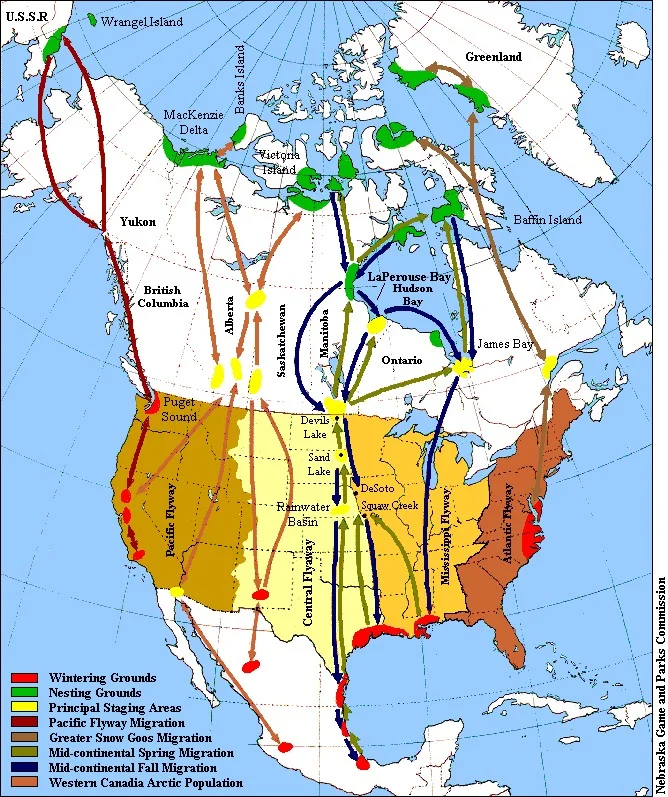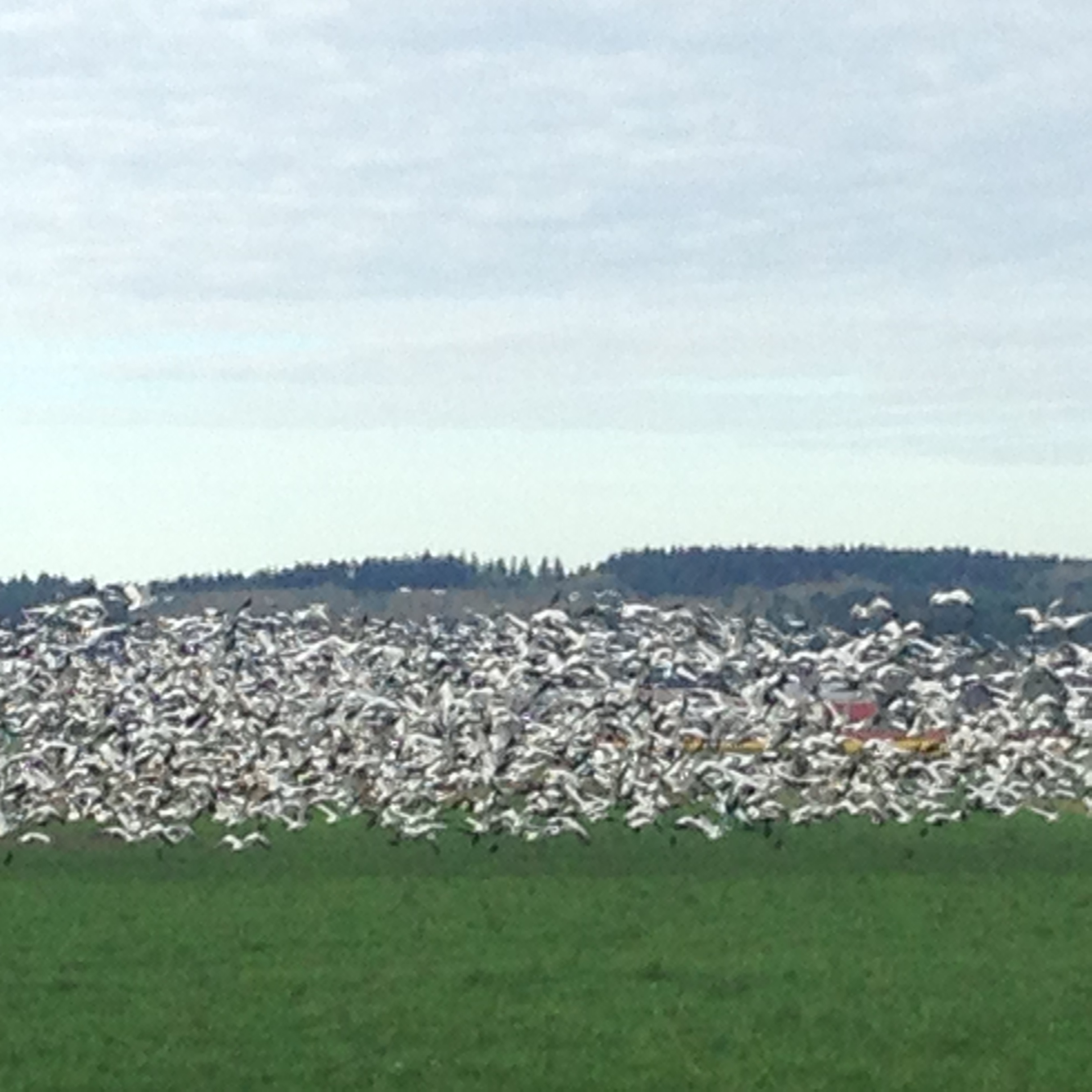On February 28, I set out for a road trip to the Skagit Valley.
Destination: Port Susan Snow Goose & Birding Festival, Stanwood, WA. This visit is the first destination of several I will take during the course of the next 12-18 months for a self-created project I am titling, "Washington Americana." I plan on visiting locations throughout Washington State for the purpose of creating landscapes documenting my journeys. I am kicking off the project by heading north from Seattle, to capture the annual migration of the Snow Geese that visit the Pacific Northwest each winter.
Approximately 70,000 snow geese come to the Northwest from Wrangell Island in Russia, about 3,100 miles away. The winter migration takes about 1-2 months depending on the prevailing winds.
The last time I saw the snow geese was about this time of year in 2009. I drove up to Fox Island Nature Center with a friend. We planned our trip to arrive early morning sunrise. That is when the birds are waking up and flying in from their water nests in the surrounding inland marshes.
Photographe 2016. Memory of 2009.
When we arrived at about 7 am, the sun was already cresting on the eastern horizon. It was a crisp morning, the dew setting its drops on the marsh grasses. It was also quiet.
"Where are the birds?" I remember asking. After walking around the preserves looking for signs of snow geese, alas there were no sight of birds on the ground. Did we miss them?
About 15 minutes into scouting, you could hear a vague "something" in the sky. Way above in the sky was a faint constellation of snow geese. They were probably a few miles away and barely perceptible with the naked eye. As they approached, the trumpeting of the birds became louder, and the constellation became larger and more dense. The trail of the migrating birds became a highway as several thousand snow geese made their approach into the Skagit Valley. As they flew overhead, we got into the car and followed their trail in the sky. It was obvious that they were about ready to land in a nearby field.
The snow geese approached their landing in a circular counter clock-wise corkscrew pattern, descending, round and round and round in a big circle until they touched ground. What was once a large dark mass in the sky was now a large white mass huddled on the green fields. They were here to feed. Not only are they noisy in the sky, they are noisy on the ground.
The only thing to add to this memory is after some time of feeding and huddling on the ground, something came by and spooked them. They then all took off resembling a big dust cloud lifting off the ground.
The shear numbers of snow geese and the manner of their presence is an experience I never forgot and knew I wanted to see again.
Fast forward to February 2016.
Port Susan Festival. Resource tables with information about climate warming: effects and solutions, birding, etc.
I was excited to learn more about this migratory annual event. What better way than to attend a guided tour of the area.
The tours provided by the Port Susan festival are free, but there are a limited in number of spots on the guided tour shuttle. I was happy to secure my spot on the coach. We departed Stanwood, WA for the 20 minute drive to Fir Island where there are dozens of fields of thousands of birds. The birds we would be seeing that day: Snow Geese (approximately 5 pounds) and Whistling Swans (approximately 20-30 pounds.)
My immediate impression: how serene it is to be amidst the pastures and fields. Being a city dweller in a region that is growing in population, I am grateful for the farmland and for the natural habitat.
While journeying out to Fir Island, I learned from my tour guide, a retired fishery biologist, that the snow geese were almost wiped out in the early 1900s. The birds were hunted and their feathers were shipped out to England and France to make hats.
En route to Fir Island via from Stanwood.
Snow Geese are protected as a migratory game bird under the Migratory Birds Convention. "In the early 1900’s hunting snow geese was severely restricted due to low population numbers. However, these days the snow goose is one of the most abundant species of waterfowl in the world. In North America the massive increase in agricultural productivity has increased winter food availability to snow geese in the form of waste grain and other food products in agricultural fields. This is resulting in a huge population boom. Now, instead of restrictive hunting, a spring conservation hunt takes place every year in an attempt to manage the ever growing population that is threatening to destroy its own breeding and wintering habitats through overpopulation. In 1999, the Arctic Tundra Habitat Emergency Conservation Act was passed in the US. This act allows the hunting of snow geese in the spring after traditional hunting season have been closed."
The Snow Geese fly the Pacific Flyway Migration route. Their flight is approximately 3,100 miles, originating from Wrangel Island, Russia/Northern Alaska/Canadian Arctic to the Pacific Coast. Depending on the wind currents, the flight can take 1-2 months.
I learned from my tour guide that the Snow Geese huddle in masses. Here is a typical gathering. Geese that huddle on the ground are called a gaggle. When they are in flight, they are called a skein, a team, or a wedge; when flying close together, they are called a plump.
The snow geese arrive in the Fraser-Skagit delta around Thanksgiving time. During the warmer winter months in the Skagit Valley, they eat enough to add approximately 25% of their body weight for the return north approximately six months later between March-May.
Snow geese keep the same partner for life. If one of the partners dies, the other will re-mate. It is very rare that pairs separate when both partners are alive. Generally snow geese pair bond at about 2 years of age during the spring. The adult snow geese are white. The youngsters are grey.
Snow Geese feed almost exclusively on plant material on the flood plains. In winter, waste grain from flood plains like the one above are a primary food source, using cover crops such as winter wheat, rye grass, and potatoes.
A group of snow geese are startled. The entire flock, approximately 2,000 birds are in the group, take to the skies to join their friends on the other side of the irrigation ditch. The squawking of the birds was extra loud as they flew overhead.
Having just escaped the danger posed by an eagle flying overhead, the geese on the perimeter of the group are on patrol, keeping an eye out in the skies for eagles, and protecting the rest of the flock.
There were lots of eagles in the area.
A bevy of swans on the horizon.
Dairy Cows. Skagit County is also known for its dairy industry, ranking 5th in dairy production in Washington State. In the early 1900s, there were as many as 900 dairies in the county. These dairy farms were small family operations where every cow had a name and mixed ancestry.
Can you see the flock of snow geese take off on the right side of the barn?
Taking off.
Sketching my notes in Pioneer Square, Seattle, after the trip. Sipping on a chai latte.
Back at home about a week after my visit in February, I sat down to sketch my memories of the Snow Geese in Skagit Valley using the photographic reference I collected on my iPhone.
Sketch: Snow Geese in field.
With sketching as it is with painting, I am able to reflect more deeply about my subject. As I put my ideas on paper, I recall the terrain, the dedication to conservation of wildlife and of the land.
Thoughts cross my mind that these farmlands and wetlands are critical to maintain and sustain, which also means that we need to keep the needs of the farmers and of conservationists in mind where there is demand for our land.
I am left with the belief that nature and humanity can go hand-in-hand and thrive when we take the whole of our shared ecosystem into consideration.
Work in Progress. Snow Geese, Skagit Valley. 4x4". Oil on Canvas. 2016
Snow Geese
Oh, to love what is lovely, and will not last!
What a task
to ask
of anything, or anyone,
yet it is ours,
and not by the century or the year, but by the hours.
One fall day I heard
above me, and above the sting of the wind, a sound
I did not know, and my look shot upward; it was
a flock of snow geese, winging it
faster than the ones we usually see,
and, being the color of snow, catching the sun
so they were, in part at least, golden. I
held my breath
as we do
sometimes
to stop time
when something wonderful
has touched us
as with a match,
which is lit, and bright,
but does not hurt
in the common way,
but delightfully,
as if delight
were the most serious thing
you ever felt.
The geese
flew on,
I have never seen them again.
Maybe I will, someday, somewhere.
Maybe I won't.
It doesn't matter.
What matters
is that, when I saw them,
I saw them
as through the veil, secretly, joyfully, clearly.
--Mary Oliver
Mary Lamery is a lifelong resident and native of the Pacific Northwest. Lamery paints regional landscape in a manner that leans towards 19th century French Impressionism. Through her project, Washington Americana, she will create original landscape paintings from her journeys through Washington for the creation of an art book of painted landscape of Washington State.
Follow me on Instagram!


















